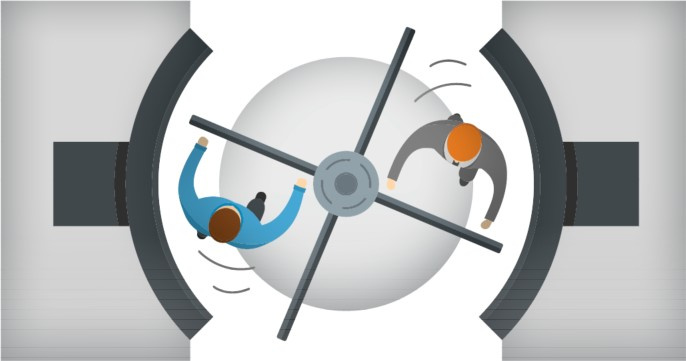Loyalty Through Better Leadership
Loyalty Through Better Leadership
Errors. Accidents. Unmet production goals. Low morale. Too many managers and company leaders accept these costly issues saying, “find me another body.” When that new hire doesn’t work out, they say it again. Eventually, many of these managers and leaders say things like, “If only I had known…”
Let’s start with a look at how companies can ensure they have the right people in the right positions and give them what they need to succeed. Then we’ll tackle how companies can set up their management to succeed in providing them an environment where their employees can thrive.

Assessing Employee Engagement
My first piece of advice when conducting an employee engagement survey is to not be afraid of, or hide, the resulting data. This is especially true if there’s bad news. It’s like going to the doctor for a checkup to identify health problems before they worsen. The health of your organization is dependent on your employee engagement levels. Poor engagement is like a cancer diagnosis–you don’t want to ignore it.
Higher engagement levels mean you’re likely doing a deliberate and thoughtful job of ensuring your talent strategy is aligned with your business strategy. People want to know that their work has meaning and is appreciated. The difference between good and bad engagement is the difference between those who show up and go the extra mile and those who are just clocking in.
The employees’ engagement levels should measure their experience (good or bad) as it relates to their job fit, their relationship to their manager, to their team, and to the organization.
Improving New-Hire Engagement
Engagement initiatives really should start in earnest on day one with targeted new-hire training. Consider getting current employees’ input on what might need to be added to this training and weight the payback on a peer-mentoring program for new hires. The onboarding process and training make a significant contribution to whether employees stay down the road. To the greatest extent possible, the entire onboarding process should be adaptable for each individual’s behavioral and learning ability. Not every new-hire will excel in an online training; conversely, not every employee will thrive if thrown immediately into on-the-job learning. It’s also important to have a plan that allows new-hires to engage in on-going training to reinforce processes, protocol, and company expectations continually.
“New hires spend the first few days with Margaret Welliver, our HR manager, and our production trainer spends time doing orientation in the shop, going through all the tools, introducing them to people, helping them, and seeing that they are succeeding in their new role,” said Tony Acampa, design team lead with Shelter Systems, Limited. “We meet with employees every week for the first eight weeks, along with their line leader and the production trainer. We go over day-to-day training and confirm each week that the job responsibilities are a good fit for the candidate and will continue to be a good fit long-term.”
Changing Company Culture
Tony points out that changing culture and implementing effective engagement tactics doesn’t happen overnight. It’s a long-term invest of time, energy, and resources.
“This company has a culture of investing in their employees,” agrees Margaret. “For example, we have the Grainger boot truck on site. They go on the truck, and employees are allotted up to $100 to buy what they need. Anything over their allotment they pay out of their pocket. They show up and the company spends $10,000 in four hours. That one event has made a big difference. People love it and it shows we know their feet need to feel good. People are just happier because we do it.”
If you have not run an engagement survey, you can glean some general insight from the SBCA production employee survey. One question asked, “What do you like about your current position?” It’s telling that only 29.59% said they felt they had an, “opportunity to advance into higher paying positions.”
There’s a myriad of reasons why new hires don’t work. Turnover is typically just a symptom of a deeper underlying problem.
Four common areas where the real problem usually lies are:
- Poor job fit.
- Ineffective leaders or managers.
- Teams that can’t or won’t play well with others.
- Cultural misalignment.
In this article, I want to explore a few ways to address the first item and then focus on a way to correct the second item on this list.
Offering career paths to help high-potential employees rise up to different roles in the organization, and employee development programs to reinforce skills, knowledge, and abilities, are both valuable employee retention initiatives. You don’t want to leave any employee out, because it can quickly lead to poor morale. In some cases, you may have to take a creative look at your organization to build different types of career pathways. One example would be creating a sawyer development program. Individuals without previous experience would start at Sawyer 1, those who meet certain time and performance benchmarks would be promoted to Sawyer 2, after they met additional benchmarks would be promoted to Sawyer 3 or a line leader. Each promotion could come with a bump in pay or other benefits. This approach gives every employee a goal to strive for and an intermediate-term career path.
The health of your organization is dependent on your employee engagement levels. Poor engagement is like a cancer diagnosis–you don't want to ignore it.
This doesn’t mean everyone in production is suddenly general manager material, but it can help you identify the individuals who might benefit from cross-training.
It may also help you identify a few diamonds in the rough.
“One of my guys is a guy that didn’t say two words to anyone on the shop floor,” said Scott Ward, principal owner of Southern Components. “Another guy mentioned that he’s a gamer. I took a chance and had him completed the PI behavioral and cognitive assessments. His PI score told me he was ideally suited for our design department. So now he’s designing. He was making $13 per hour in production, and now he’s pulling in $45,000 a year behind a computer. It changed his whole career path; probably his life.”
Too often, mediocre or poor managers drive otherwise good employees away.
Addressing Management Challenges
Too often, mediocre or poor managers drive otherwise good employees away. In my experience, an individual who is tasked with leading others needs to start with a self-assessment of their strengths and weaknesses, and understand how they work in concert with others’ strengths and weaknesses. Without this knowledge, “blind leadership” can have a costly impact on your company’s ability to retain employees.
In that same SBCA survey, only 29.25% of respondents said, “I feel my supervisor and/or the owner cares about me.” One person even took the opportunity to add the comment that, “I love my job, supervisor or NOT.” The survey also asked, “What don’t you like?” In response, 32.50% identified management style as a top concern.
Further, a majority (52.5%) of the “other” responses to this question contained a litany of complaints and comments ranging from salaries to shifts, and from managers to culture. Some notable comments were, “managers playing favorites,” and “the atmosphere is pure gossip,” and “the supervisor does more for some than for others,” and, “the abundance of favoritism,” and, “the lack of communication,” and, “top management focuses on the bottom line only.”
With pervasive sentiments like these, it may be helpful to conduct a 360 Assessment (see sidebar) to gather feedback on your managers’ performance. This powerful evaluation tool can assist you in taking target action in helping managers improve their performance as leaders.
“Knowing your people is half the battle,” said Mike Kozlowski, P.E., president of Apex Technology. Mike has attended the PI training, one of the management training programs conducted by Business Results. “We have the tools, the tips and tricks on how to use each behavioral index, but it really just comes down to, ‘know your people. Know what encourages them. Know how to speak to them. Speak to people in their language so they understand you.’”
Many frontline managers lack formal management training. So, it’s vital company’s proactively identify and address the weaknesses of your supervisors and reinforce a culture that sets their company leaders up for success.
The 360 Assessment
The 360-degree analysis provides managers and leaders greater insight and understanding into the values and behaviors that are important for your organization’s success. Rated competencies include key leadership aspects like emotional intelligence, communication, and relationship building.
The CATIL 360 surveys managers from different perspectives (their superiors, peers, direct reports, etc.), highlighting their blind spots and hidden strengths so that company leaders can create objective and realistic development plans for each manager.
Bottom Line
Before you start thinking, “I don’t have time for all this touchy, feely nonsense,” keep this in mind: The SBCA production survey respondents indicated that the actual work being asked of them is viewed as good, solid, and honest. But the employees doing this work are not automatons. They are not just assets. They are people. When you invest in their morale and engagement (beyond the wages, etc), those employees, your people, will invest back in the company with loyalty and quality output.
Want to Learn More?
Dolly Penland presented the recent SBCA Webinar, “How to Attract, Hire and Retain Top Talent.” You can access the recording at sbcindustry.com/webinars. SBCA members can also receive a 10% rebate on their Year 1 subscription to the Predictive Index or CATIL software purchased through Business Results, LLC (businessresultsllc.com).
leadership development.

